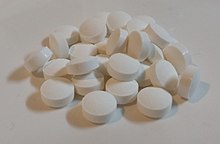Zinc deficiency
[3] Zinc deficiency may manifest as acne,[4] eczema, xerosis (dry, scaling skin), seborrheic dermatitis,[5] or alopecia (thin and sparse hair).
[6] Zinc deficiency can manifest as non-specific oral ulceration, stomatitis, or white tongue coating.
[14] Impaired immune function in people with zinc deficiency can lead to the development of respiratory, gastrointestinal, or other infections, e.g., pneumonia.
[3][19] Moderate and more severe zinc deficiencies are associated with behavioral abnormalities, such as irritability, lethargy, and depression (e.g., involving anhedonia).
[20] Zinc supplementation produces a rapid and dramatic improvement in hedonic tone (i.e., general level of happiness or pleasure) under these circumstances.
Animal studies indicate that maternal zinc deficiency can upset the sequencing and efficiency of the birth process.
An increased incidence of difficult and prolonged labor, hemorrhage, uterine dystocia, and placental abruption has been documented in zinc-deficient animals.
[29] Zinc deficiency can interfere with many metabolic processes during infancy and childhood, a time of rapid growth and development when nutritional needs are high.
[30] Low maternal zinc status has been associated with less attention during the neonatal period and worse motor functioning.
Recent research findings suggest that increasing atmospheric carbon dioxide concentrations will exacerbate zinc deficiency problems in populations that consume grains and legumes as staple foods.
A meta-analysis of data from 143 studies comparing the nutrient content of grasses and legumes grown in ambient and elevated CO2 environments found that the edible portions of wheat, rice, peas and soybeans grown in elevated CO2 contained less zinc and iron.
[6] It presents as growth retardation, severe diarrhea, hair loss, skin rash (most often around the genitalia and mouth) and opportunistic candidiasis, and bacterial infections.
[6] Numerous small bowel diseases which cause destruction or malfunction of the gut mucosa enterocytes and generalized malabsorption are associated with zinc deficiency.
[citation needed] Exercising, high alcohol intake, and diarrhea increase the body's loss of zinc.
[5][39] Changes in intestinal tract absorbability and permeability due, in part, to viral, protozoal, or bacteria pathogens may also encourage fecal losses of zinc.
Zinc is a critical component of the catalytic site of hundreds of kinds of different metalloenzymes in each human being.
[52] Diagnosis is typically made based on clinical suspicion and a low zinc level in the blood.
[34] Providing micronutrients, including zinc, to humans is one of the four solutions to major global problems identified in the Copenhagen Consensus from an international panel of economists.
In 1974 the National Academy of Sciences declared zinc to be an essential element for humans and established a recommended daily allowance.
In the 1990s there was increasing attention on the role of zinc deficiency in childhood morbidity and mortality in developing countries.
[64] In China, zinc deficiency occurs on around half of the agricultural soils, affecting mainly rice and maize.
[65] Balanced crop nutrition supplying all essential nutrients, including zinc, is a cost-effective management strategy.
Central Anatolia, in Turkey, was a region with zinc-deficient soils and widespread zinc deficiency in humans.
Nearly ten years after the identification of the zinc deficiency problem, the total amount of zinc-containing compound fertilizers produced and applied in Turkey reached a record level of 300,000 tonnes per annum.
It is estimated that the economic benefits associated with the application of zinc fertilizers on zinc-deficient soils in Turkey is around US$100 million per year.


